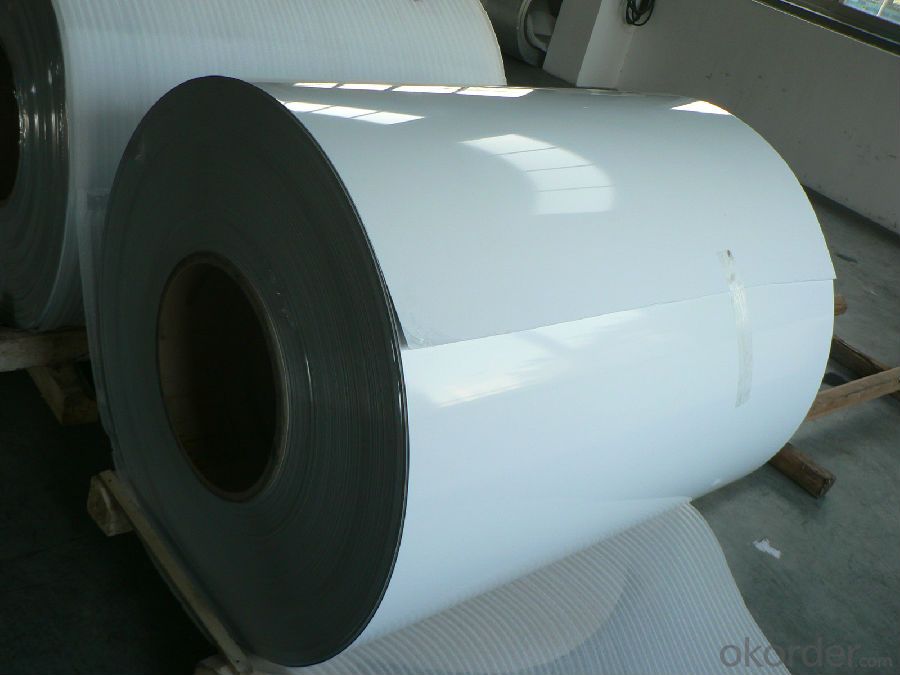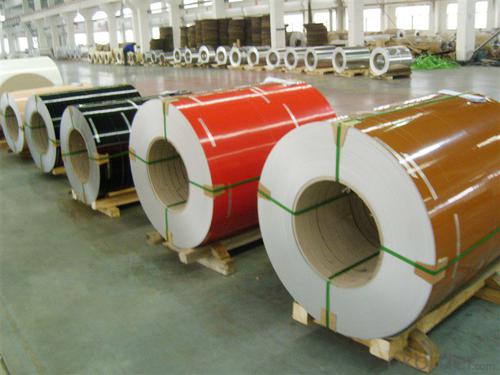Cricut Cut Prepainted Aluminum Coil for Decoration
- Loading Port:
- Shanghai
- Payment Terms:
- TT OR LC
- Min Order Qty:
- 8 m.t.
- Supply Capability:
- 1000 m.t./month
OKorder Service Pledge
OKorder Financial Service
You Might Also Like
Specification
Structure of Aluminium Prepainted in Coil Form for Decoration Description:
Coated aluminum coil/sheet are of a wide range of colors, which gives wonderful appearance no matter in residential and commercial constructions of great exhibition centers.
The coated aluminum coil/sheet have been widely used in the fields of construction and decoration( garage doors, ceiling etc.), electronic appliances, lighting decoration, air-condition air pipes, sandwich panels and drainages etc.
Main Features of the Aluminium Prepainted in Coil Form for Decoration:
1) High flexibility
2) Impact resistance
3) Excellent weather-proof durability
4) Anti-ultraviolet
5) High erosion resist
Images of the Aluminium Prepainted in Coil Form for Decoration:



Aluminium Prepainted in Coil Form for Decoration Specification:
Alloy | A1100,A3003,A1050,A8011 etc |
Temper | H16,H18,H24 |
Thickness | From 0.024mm to 1.2mm |
Width | Standard width:1240mm |
Special width:1300mm,1520mm,1570mm,1595mm | |
Diameter | Standard dia:1200mm |
Interior dia:150mm,405mm,505mm | |
Weight | 2.5 T/coil,3.0 T/coil |
Coating | PE, PVDF, AC |
Surface | Embossed, mill finish, coated |
Color | AS to code RAL |
Gloss | 10-90%(EN ISO-2813:1994) |
Coating Thickness | PE: more than 18 micron |
PVDF: more than 25 micron | |
Coating Hardness (pencil resistance) | More than 2h |
Coating adhesion | 5J(EN ISO-2409:1994) |
Impact Resistance | No peeling or cracking(50 kg/cm,ASTMD-2794:1993) |
Flexibility (T-bend) | 2T |
MEK resistance | More than 100 |
FAQ:
a.What is monthly capacity
---CNBM is one stated own company and our monthly capacity is about 2000tons.
b. Now which countries do you export your goods?
---Now we export to South East Asia,Africa, North America,South America ect.
- Q: What is the thickness of the aluminum sheets?
- The thickness of the aluminum sheets can vary depending on the specific product or application. Aluminum sheets are available in a wide range of thicknesses, typically ranging from 0.006 inches (0.15 mm) to 0.25 inches (6.35 mm) or even thicker. The appropriate thickness will depend on the specific requirements and intended use of the aluminum sheet.
- Q: Can aluminum sheets be anodized with custom colors?
- Custom colors can indeed be applied to aluminum sheets through the process of anodizing. Anodizing involves the application of an electrochemical procedure that adds a protective oxide layer to the aluminum's surface, thereby enhancing its durability and resistance to corrosion. In this process, the aluminum sheet is submerged in an electrolytic solution while an electrical current is passed through it. This induces a controlled oxidation of the aluminum's surface, leading to the formation of a porous layer that can be colored with dyes to achieve desired shades and hues. By carefully selecting the appropriate dye, a wide array of custom color options can be achieved. Moreover, anodized aluminum sheets offer versatility as they can undergo additional treatments like laser engraving or printing to create distinctive designs and patterns. Therefore, they are highly suitable for a diverse range of applications in industries such as architecture, automotive, and electronics.
- Q: Are aluminum sheets suitable for HVAC systems?
- Indeed, HVAC systems find aluminum sheets to be a fitting choice. As a lightweight and sturdy material, aluminum boasts exceptional thermal conductivity, rendering it highly suitable for integration into HVAC systems. It frequently serves as the base for crafting ductwork, heat exchangers, and fins within air conditioning units. Moreover, aluminum sheets exhibit corrosion resistance, which proves advantageous in settings with elevated humidity levels or instances of moisture exposure. Furthermore, aluminum stands as an eco-friendly alternative as it can be recycled, solidifying its status as an environmentally conscious option for HVAC systems. All in all, aluminum sheets present a multitude of advantages and remain widely embraced within the HVAC industry.
- Q: How does the price of 101 aluminum sheets compare to other aluminum alloys?
- The price of 101 aluminum sheets can vary depending on various factors such as market conditions, demand, and supply. However, generally speaking, 101 aluminum alloy is considered to be one of the most affordable options among aluminum alloys. It is often chosen for its relatively low cost and good overall performance. Compared to other aluminum alloys, especially high-strength alloys such as 7075 or 6061, the price of 101 aluminum sheets tends to be lower. This is because 101 aluminum is a relatively simple alloy with a lower composition of alloying elements, making it less expensive to produce. However, it is important to note that the price differentiation between aluminum alloys can vary depending on current market conditions and specific requirements. Factors such as the thickness, size, and quantity of sheets required can also impact the final price. Therefore, it is always recommended to check with suppliers or manufacturers to get the most accurate and up-to-date pricing information for 101 aluminum sheets compared to other aluminum alloys.
- Q: What are the standard thicknesses for aluminum sheets utilized in construction?
- <p>Yes, there are standards for the thickness of aluminum sheets used in construction. These standards vary by country and application. In the United States, the Aluminum Association sets standards, such as AA 3003-H14, which is commonly used in construction for thicknesses ranging from 0.020 to 0.250 inches. In Europe, EN 485-2 covers the specifications for aluminum sheet thicknesses. Thicknesses can range from 0.4mm to 6.0mm, depending on the specific requirements of the construction project. It's important to consult the relevant standards for the region and application to ensure compliance and proper material selection.</p>
- Q: Which kind of glue can bond hard shell plastic and iron sheet or aluminum sheet?
- you can use 520 or AB glue, and I think 520 is better.
- Q: Can aluminum sheets be bent or formed into different shapes?
- Certainly, aluminum sheets possess the capability to be bent or molded into diverse configurations. This metal, aluminum, possesses remarkable malleability, signifying that it can be effortlessly shaped or molded without experiencing any fractures or fissures. This characteristic renders it highly adaptable for an array of industries and applications. By bending, rolling, or pressing aluminum sheets, an assortment of shapes or structures can be brought to life, including cylinders, cones, or intricate geometric formations. The capacity to bend or mold aluminum sheets unveils an extensive scope of opportunities for the manufacturing, construction, automotive, aerospace, and countless other sectors.
- Q: How do you achieve a mirror-like finish on aluminum sheets?
- To achieve a mirror-like finish on aluminum sheets, a multi-step process is usually followed. First, the sheets are thoroughly cleaned and degreased to remove any dirt or oils. Then, they are sanded with progressively finer grits of sandpaper to smooth out any imperfections. Next, a polishing compound is applied and buffed onto the surface using a rotating wheel or by hand. This step is repeated with finer and finer compounds until the desired level of shine is achieved. Finally, a protective coating might be applied to maintain the mirror-like finish.
- Q: Can aluminum sheets be an alternative to glass in certain applications?
- Yes, aluminum sheets can be an alternative to glass in certain applications. Aluminum sheets offer several advantages over glass, making them a suitable choice in specific scenarios. Firstly, aluminum sheets are lightweight and durable, making them ideal for applications where weight is a concern, such as in aerospace or automotive industries. Glass, on the other hand, is relatively heavy and brittle, which can limit its use in certain environments. Additionally, aluminum sheets have excellent corrosion resistance, making them suitable for applications in marine or coastal environments where glass may deteriorate over time due to exposure to saltwater. Aluminum sheets also have a high strength-to-weight ratio, allowing for greater design flexibility and structural integrity compared to glass. Moreover, aluminum sheets can provide better thermal insulation properties compared to glass. They offer improved heat transfer resistance, which can be advantageous in applications where temperature control is crucial, such as in the construction industry. Furthermore, aluminum sheets can be more cost-effective than glass in certain applications. The production and installation costs of aluminum sheets are often lower compared to glass, making them a more economical choice for large-scale projects. However, it is important to note that glass still has its own unique properties and advantages that make it the preferred choice in many applications, such as its transparency and optical clarity. Glass also offers better resistance to scratches and chemical corrosion compared to aluminum sheets. In conclusion, while aluminum sheets can be a viable alternative to glass in certain applications due to their lightweight, durability, corrosion resistance, thermal insulation properties, and cost-effectiveness, the choice between the two materials ultimately depends on the specific requirements and constraints of the application in question.
- Q: What's the difference between laser cutting aluminum plate and stainless steel plate?
- The absorptivity of aluminum plate and stainless steel plate to laser is different. The aluminum plate is more reflective and easier to be removed during cutting
Send your message to us
Cricut Cut Prepainted Aluminum Coil for Decoration
- Loading Port:
- Shanghai
- Payment Terms:
- TT OR LC
- Min Order Qty:
- 8 m.t.
- Supply Capability:
- 1000 m.t./month
OKorder Service Pledge
OKorder Financial Service
Similar products
Hot products
Hot Searches
Related keywords




























